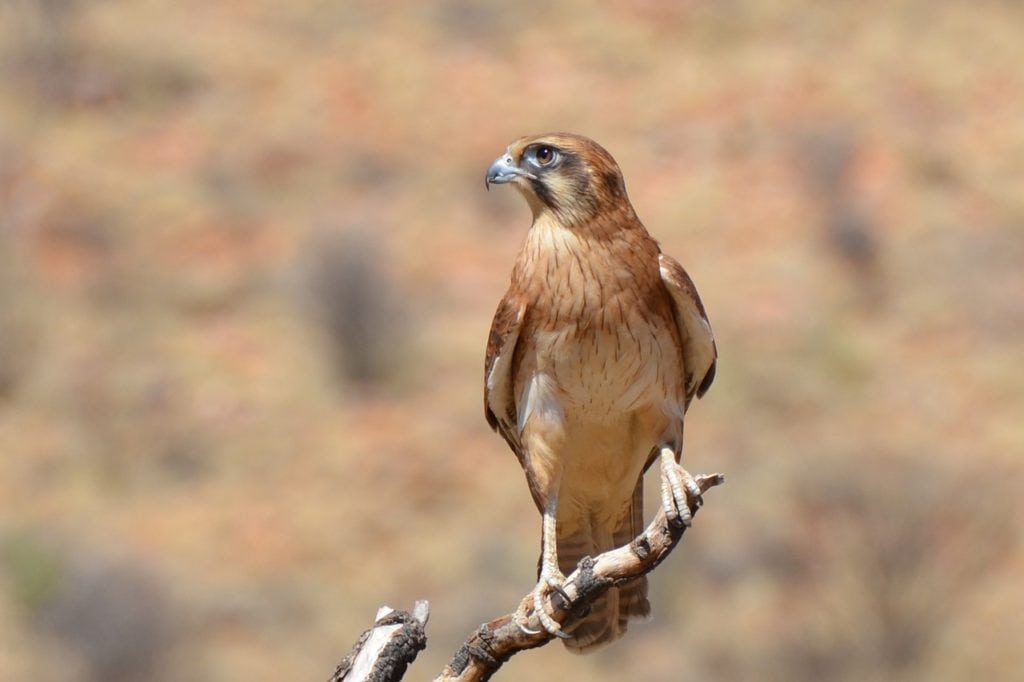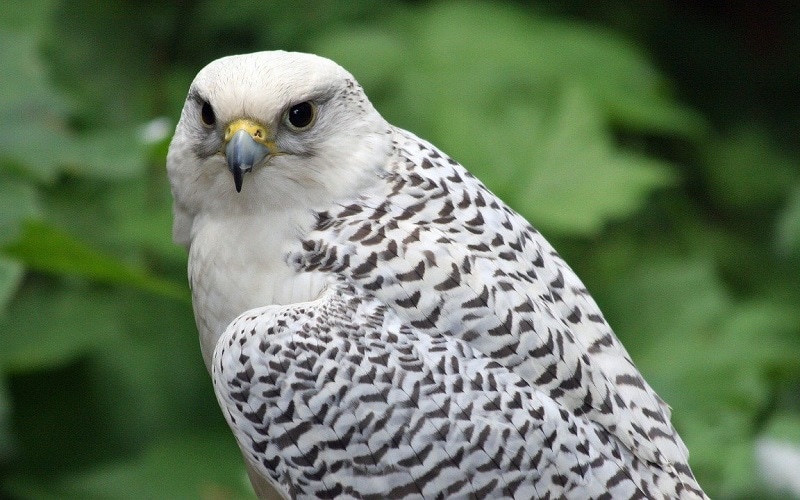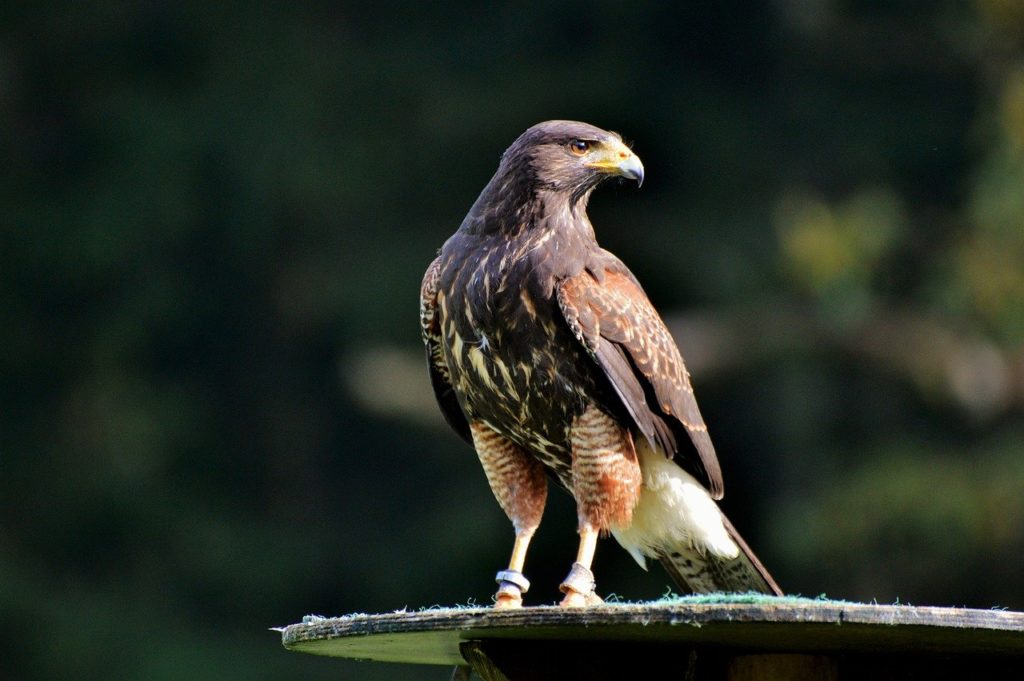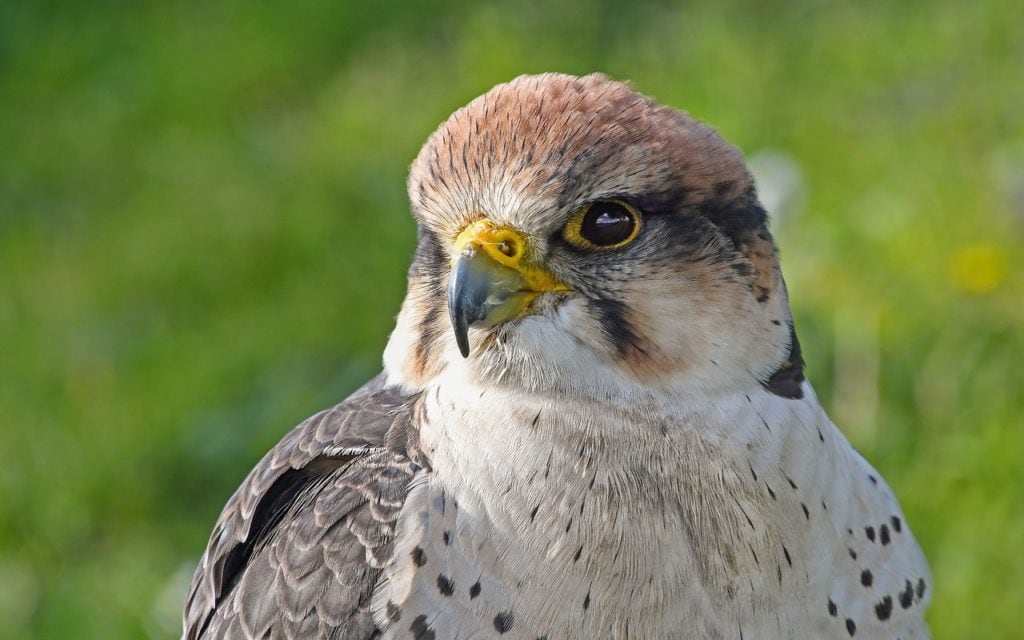12 Fascinating & Fun Falcon Facts You Never Knew
Last Updated on

Did you know the state of Idaho has a raptor as an insignia of the state? It’s the Peregrine falcon. And the reason why they chose this species to represent their community values, is clear and simple — the bird always seems to have something special to offer.
Anyway, that special “something” is what we’ll be discussing today. So, if you don’t mind, we would like to stop wasting time, and get right to it.
These are the facts that left our mouths wide open with incredulity!

The 12 Most Interesting Facts About Falcons
1. A falcon is a bird of prey, also known as a raptor.
A bird that purely feeds on other birds, fish, mammals, amphibians, or even insects, is referred to as a bird of prey or raptor. And they are often classified into two orders: they can either be Strigiformes, or Falconiformes.
The falcon, together with the eagle, hawk, condor, and every other diurnal raptor that you can think of, belong to the order Falconiform. Their beaks (bills) are always hooked, and their claws are incredibly sharp.
Also, you’ll mostly find them at the top of the food chain, as the apex predator. Apex predators typically don’t have other animals preying on them. Well, apart from humans, of course.

2. The Gyrfalcon is the largest falcon on the planet.
If you dig through your history books, you’ll learn that some scholars believe that the Peregrine falcon is the largest bird in the falcon family. But we respectfully disagree. We are of the opinion that the Gyrfalcon is actually the largest falcon species, and we have scientific proof to back that up.
The reason why there’s no consensus as to which falcon is bigger is that the Gyrfalcon is rarely seen. They prefer building homes in areas that experience very low temperatures, like the High Arctic. We sincerely have nothing against them, but those places are not the type of places that you’ll want to hang out if you’re warm-blooded.
Something else that we found to be hilarious is that the Gyrfalcon doesn’t really care about those freezing temperatures during the breeding season. They’ll just go about their business as if everything’s normal and lay their eggs.
Is that all? No.
We were also told that in the Middle Ages, this bird was so highly regarded that only kings were allowed to own one, or even hunt one.

3. The Peregrine Falcon is arguably the most popular falcon.
They might not be the largest falcon on the planet, but they sure are the most common. And it’s not all that difficult to distinguish them from other birds, seeing as they usually have very long tails and pointed wings.
As with most birds, the general appearance of adults and juveniles is very different. You’ll realize that the juveniles come with vertical streaks and some heavy markings, while the adults have barred underparts with blue-gray colorings above.
The males usually appear smaller than the females, with approximate length and wingspan measurements of 14.2–19.3 inches and 39.4–43.3 inches, respectively.
4. The perfect hunting friend is the Peregrine Falcon.
Any falconer will confirm this: The Peregrine falcon is the best raptor partner that you’ll ever have if you’re planning to go out hunting.
First off, they are very easy to train. Easier than any other bird of prey that has ever been trained before. Secondly, their hunting disposition is unparalleled. We already knew that they were born to hunt but seeing it in action was still quite impressive. And lastly, ornithologists suspect that they collect, and process information differently compared to other birds — this could be the reason why they respond to stimuli incredibly well.
The easiest prey to catch using a Peregrine falcon is grouse. But if you’re thinking of going for variety, then you could also go for pheasants, pigeons, and ducks.

5. Falcons have astounding eyesight.
There’s no disputing the fact that the relative eye size of an ordinary bird of prey is significantly larger than those of most bird species. And this applies to birds found in almost every other ecosystem. However, if you get the opportunity to study those eyes at their cellular level, you’ll learn that size doesn’t quite contribute anything of value in how great their visions are.
Several other eye adaptations make the falcon great at what it does. Talk about the multiple foveae, for example. This feature is virtually the hallmark of any diurnal raptor, as it combines the bird’s stereoscopic vision with panoramic sight to give it the advantage it needs to capture its prey.
There’s also the ganglion cell feature that they all have in abundance. For those of you who don’t know what those are, they are the cells tasked with processing any sort of visual information that enters your eye.
Once that information has been successfully registered, it will be transmitted to the bird’s brain through their axons and trigger a response — axons are essentially lengthy fibers that come together to form an optic nerve.
We would be remiss, if we talked about the different eye adaptations of the falcon, without talking about their retinal convergence ratio. This ratio is shockingly low, meaning their photoreceptors don’t heavily rely on never fibers as is typical for most animals.
To sum it up, the falcon’s ganglion cells and photoreceptors are the chief features that maximize their visual resolution.

6. The Peregrine Falcon is the fastest living creature.
We’ll bet you dollars to doughnuts that the cheetah is the first thing that comes to mind whenever you hear someone talk about the fastest animal to ever exist. And that’s purely because most people aren’t as interested in birds the way they are in mammals.
According to our sources, the Peregrine falcon can cover 65 to 75 miles per hour when it’s flying at top speed. And they could still go as fast as 200 miles per hour while diving.
That dive is what researchers refer to as the ‘Stoop’ and it’s the reason why the Peregrine falcon is the undisputed speeding champion. No animal on land or air can top that speed.
7. The Grey Falcon is the rarest falcon.
Sometimes referred to as the Smoke or Blue Hawk, the Grey Falcon is so rare that it can only be found in New Guinea, Tasmania, or mainland Australia. They prefer staying far away from humans, but if they have to, they’ll build homes in areas that have a low-density population.
We noticed that they aren’t as small as some people want us to believe, as they fall between the Nankeen Kestrel and Peregrine falcon. That is in both the length measurement and wingspan.
Being a bird of prey, the Grey falcon will prey on anything made of flesh or has an exoskeleton. However, if it had an option, it would only pursue small birds like the parrot, duck, pigeon, and thornbill.
The Grey falcon will lay 2 to 3 eggs per clutch, and they are supposed to be incubated for 34 to 36 days.
Its nesting behavior is so different from those of other species, and the reason why their populations are growing at a snail’s pace. A healthy, mature pair will only breed once a year, and if that year is riddled by drought, they won’t breed at all.
There are times when they’ve been open to the idea of producing a second clutch should the conditions improve, but we wouldn’t hold our breaths if we were you.

8. Crested caracara looks more like a vulture and a hawk than a falcon.
Let’s assume for a quick second that the vulture and a hawk decided to have a baby. That baby would be the Crested caracara since nearly all its physical features either resemble those of a vulture or a hawk. That includes its orange face and exaggerated talons.
Anyway, the Crested caracara mainly feeds on carrion, but if you look at our bird classification charts, you’ll find them listed under omnivores. Of course, that’s primarily because they sometimes partake of berries, reptiles, insects, plants, fish, and even worms, when their food sources are running low.
We came to learn that they are also so good at hunting, but not as good as the Peregrine falcon or the Merlin — which is also a falcon species, just so you know.
Now that we’ve thought about it, those hunting impulses could be the reason why they have such exaggerated talons. And the vulture-looking face is an attribute best explained by the fact that they’ve been spotted on more than one occasion, feeding on roadkill.
Social monogamy and sexual monogamy are two very different concepts. Sexual monogamy is a situation whereby the pair decides to be mutually exclusive. This will ensure that the babies being born will only share DNA with the mother and father.
Social monogamy, on the other hand, focuses more on the male’s role in parenting. The male will defend its nest and territory while feeding his family, even if the kids aren’t his. So, what we’re basically saying is, a bird can be socially monogamous, but not sexually.
In the case of the falcon, monogamy is practiced in all aspects.

10. The falcon chick’s rate of growth is unbelievably high.
Falcons are gluttonous in nature. They spend most of their time either eating or thinking about where the next meal is going to come from.
And it’s not that they don’t have better things to do. It’s just that the way their physiological systems have been designed, compels them to utilize so much energy while hunting. So, if you see them feeding, they’ll essentially be replacing what they’ve used to hunt down that prey.
It seems like this appetite is usually passed down to their offspring because they too eat like crazy. They’ll be twice their weight in less than a week, and 10 times their birth size in a month.
11. The male falcon is called a tiercel.
Naturally, most male birds are smaller in size compared to their female mates. It’s so rare to find a species that has the male grow to become bigger than the female if you think about it. So, to say that we were surprised to see the male falcon appear smaller than its female mate would be a lie.
The only thing that shocked us, to be completely honest, was how small it was. It’s almost a third smaller, and that’s why it’s called the ‘tiercel’ — tiercel means one-third.
12. The falcon is a protected bird.
For so many years, people keep hunting or trapping falcons around the world. Some even went as far as destroying their nests or stealing their eggs. Conservationists never caught a whiff of what was going on up until the 60s, when they realized their populations were suddenly decreasing at an alarming rate.
They began digging, trying to figure out what the problem was, and that’s how they discovered humans were the falcon’s greatest enemy.
In addition to persecuting this species, we were also manufacturing pesticides that were affecting them indirectly. The chemicals used in manufacturing those pesticides contaminated almost every bird in the wild, which in turn contaminated the falcon preying on them.
Conservationists knew the only way to curb this menace was to enact a law that would make it illegal to hunt, trap, or domesticate falcons, and all the other birds listed as endangered. They also started raising chicks in captivity, before releasing them back into the wild.

Wrapping it up
And those are the few falcon facts that we gathered today. We know that there are still so many facts out there that we’re yet to learn, so we would appreciate it if you would reach out and share what you recently discovered.
Also, if you see anybody out there trying to hunt a falcon, don’t be afraid to report them to the authorities. We believe we all have a part to play if we want to save this planet and its occupants.
Featured Image Credit: Pixabay
Table of Contents
- The 12 Most Interesting Facts About Falcons
- 1. A falcon is a bird of prey, also known as a raptor.
- 2. The Gyrfalcon is the largest falcon on the planet.
- 3. The Peregrine Falcon is arguably the most popular falcon.
- 4. The perfect hunting friend is the Peregrine Falcon.
- 5. Falcons have astounding eyesight.
- 6. The Peregrine Falcon is the fastest living creature.
- 7. The Grey Falcon is the rarest falcon.
- 8. Crested caracara looks more like a vulture and a hawk than a falcon.
- 9. Falcons subscribe to both social and sexual monogamy.
- 10. The falcon chick’s rate of growth is unbelievably high.
- 11. The male falcon is called a tiercel.
- 12. The falcon is a protected bird.
- Wrapping it up
About the Author Robert Sparks
Robert’s obsession with all things optical started early in life, when his optician father would bring home prototypes for Robert to play with. Nowadays, Robert is dedicated to helping others find the right optics for their needs. His hobbies include astronomy, astrophysics, and model building. Originally from Newark, NJ, he resides in Santa Fe, New Mexico, where the nighttime skies are filled with glittering stars.
Related Articles:
How to Clean a Refractor Telescope: Step-by-Step Guide
How to Clean a Telescope Eyepiece: Step-by-Step Guide
How to Clean a Rifle Scope: 8 Expert Tips
Monocular vs Telescope: Differences Explained (With Pictures)
What Is a Monocular Used For? 8 Common Functions
How to Clean a Telescope Mirror: 8 Expert Tips
Brightfield vs Phase Contrast Microscopy: The Differences Explained
SkyCamHD Drone Review: Pros, Cons, FAQ, & Verdict
